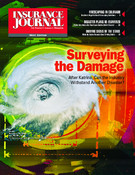With the horrors from Hurricane Katrina still flashing on live TV, Connecticut emergency officials and Gov. M. Jodi Rell (R) met recently to decide how to evacuate 100,000 coastal residents if a Category 4 hurricane hit Long Island Sound. The answer? Just about every which way–from cars to trains to buses.
Connecticut’s emergency strategy session was one of many hard looks triggered by Hurricane Katrina as a growing number of states combed through their disaster plans in hopes of avoiding another New Orleans catastrophe. Key among many of these impromptu summits was scrutiny of plans for evacuating and for keeping communication channels open.
California Sen. Dianne Feinstein (D) and Rep. Richard Pombo (R-Calif.) have called the failure of New Orleans’ levees to contain floodwaters a “wake-up call for Californians.” They urged the Army Corps of Engineers to address the deterioration of levees that channel river water in the Sacramento-San Joaquin Delta and that experts say could be vulnerable to floods and earthquakes.
“As we have seen in New Orleans, it would be a dramatic mistake to further delay the repairs that are necessary to protect communities from the ravages of floodwaters,” Feinstein said in a press release.
In Hawaii, an island chain 2,500 miles from the nearest major landmass, the threat of tsunamis, hurricanes and other large-scale disasters weighs heavily on the minds of emergency planners, especially concerns about inadequate space in public shelters.
“The big problem with an island jurisdiction like us is that we can’t evacuate to another state when a hurricane comes through,” said Larry Kanda, a mitigation planner in Hawaii’s Civil Defense division.
State emergency managers in Hawaii say Katrina underscores the need for an additional 124,000 spaces in short-term shelters such as community centers and public schools to properly cope with a major natural disaster. Kanda said state officials are working to retrofit public buildings to serve as public shelters in emergencies. A proposal before the Hawaii Legislature would allocate $4 million in state funds over two years for disaster preparedness. Part of the money would reimburse residents for some costs of making their homes more resistant to high winds and rising waters.
Tsunami fears also have plagued the West Coast since last December’s massive tidal wave in Southeast Asia. A June 14 earthquake off the U.S.’s Northwest coast triggered a short tsunami warning that forced the evacuation of about 10,000 people from low-lying areas in Oregon and allowed state officials to test for holes in their disaster-response plan.
Jay Wilson, earthquake and tsunami coordinator in Oregon’s Office of Emergency Management, said June’s false alarm and the problems officials along the Gulf Coast faced after Katrina have offered reminders about the importance of ensuring that first responders can communicate with each other and the public in times of crisis.
Wilson said Katrina also highlighted the specific challenges that the elderly, disabled and poor face during disasters. “Emergency management officials, law enforcement officials and public health officials might reassess how well those plans are designed to deal with those populations.”
© Copyright 2005 Stateline.org.
Was this article valuable?
Here are more articles you may enjoy.


 AIG Sues Newly Launched Dellwood Insurance and Its Founders
AIG Sues Newly Launched Dellwood Insurance and Its Founders  Trump’s Bond Insurer Tells Judge Shortfall Is ‘Inconceivable’
Trump’s Bond Insurer Tells Judge Shortfall Is ‘Inconceivable’  Coral Gables, Florida Tops Beverly Hills as Ritziest Home Market in US
Coral Gables, Florida Tops Beverly Hills as Ritziest Home Market in US  USAA to Lay Off 220 Employees
USAA to Lay Off 220 Employees 


